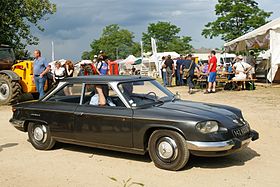Panhard 24
| Panhard 24 | |
|---|---|
 |
|
| Overview | |
| Manufacturer | Société des Anciens Etablissements Panhard et Levassor |
| Production | 1964 - 1967 28,651 produced |
| Designer | Louis Bionier |
| Body and chassis | |
| Class | Mid-size |
| Body style | 2-door coupé 2-door sedan |
| Layout |
Front engine front-wheel drive |
| Powertrain | |
| Engine | 848 cc two-cylinder boxer motor 42 or 50 hp at 5250 or 5750 rpm |
| Transmission | 4-speed manual |
| Dimensions | |
| Wheelbase | 2,286 mm (90.0 in) or 2,550 mm (100 in) |
| Length | 4,267 mm (168.0 in) or 4,550 mm (179 in) |
| Width | 1,620 mm (64 in) |
| Height | 1,220 mm (48 in) |
| Curb weight | 840 kg (1,850 lb) (approx) |
| Chronology | |
| Predecessor | Panhard PL 17 |
| Successor | Citroën GS |
The Panhard 24 is a compact two-door coupé automobile produced between 1964 and 1967 by French manufacturer Panhard. It was powered by a front-mounted air-cooled two-cylinder boxer motor: the basic design of this unconventional engine dated back to the 1940s. In 1965 a lengthened Panhard 24 was launched and promoted as a two-door four- or five-seat saloon. Plans for a four-door version which might have enabled the car more effectively to replace the commercially successful Panhard PL 17 saloon were never implemented, however.
Although the 24 had no Panhard badged successor, a number of the features of the Citroën GS which appeared (after an unusually long gestation period) in 1970 respected Panhard traditions. The Panhard 24 may be thought of as the swan song of Panhard automobile production (since 1967 the Panhard business has concentrated on manufacturing light military vehicles).
Panhard was among the earliest automobile producers and, by some criteria, the first volume auto producer in the world, back in 1890.
In 1955 Citroën had taken a 25% holding in Panhard's automobile business and from this time onwards the two brands were increasingly managed as a single range. During the next two years the national dealership networks of the two businesses were integrated. This gave Citroën and Panhard dealers an expanded market coverage, incorporating now a small car, a medium-sized saloon and a large car range. It gave Citroën desperately needed production capacity at Panhard's Ivry plant which from now on produced Citroën 2CV Fourgonettes (light vans) alongside Panhard sedans.
In the second half of the 1950s, the integration of the sales and service networks energised sales of the Panhard Dyna Z and of its successor, the Panhard PL 17. Nevertheless, product development decisions tended to favour the Citroën brand ahead of Panhards, which also seem to have lost out to the Citroën Fourgonette in respect of production capacity allocation.
During the later 1950s the Citroën DS range extended its appeal downmarket with the relatively aggressively priced Citroën ID. 1961 saw the launch of the Citroën Ami, effectively representing an upmarket and modernised version of the Citroën 2CV. It is also clear that plugging the gap in Citroën's range with a Citroën branded model was being mooted many years before the arrival, in 1970, of the Citroën GS.
...
Wikipedia
